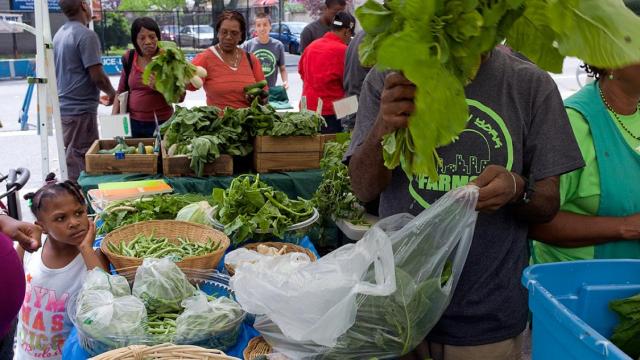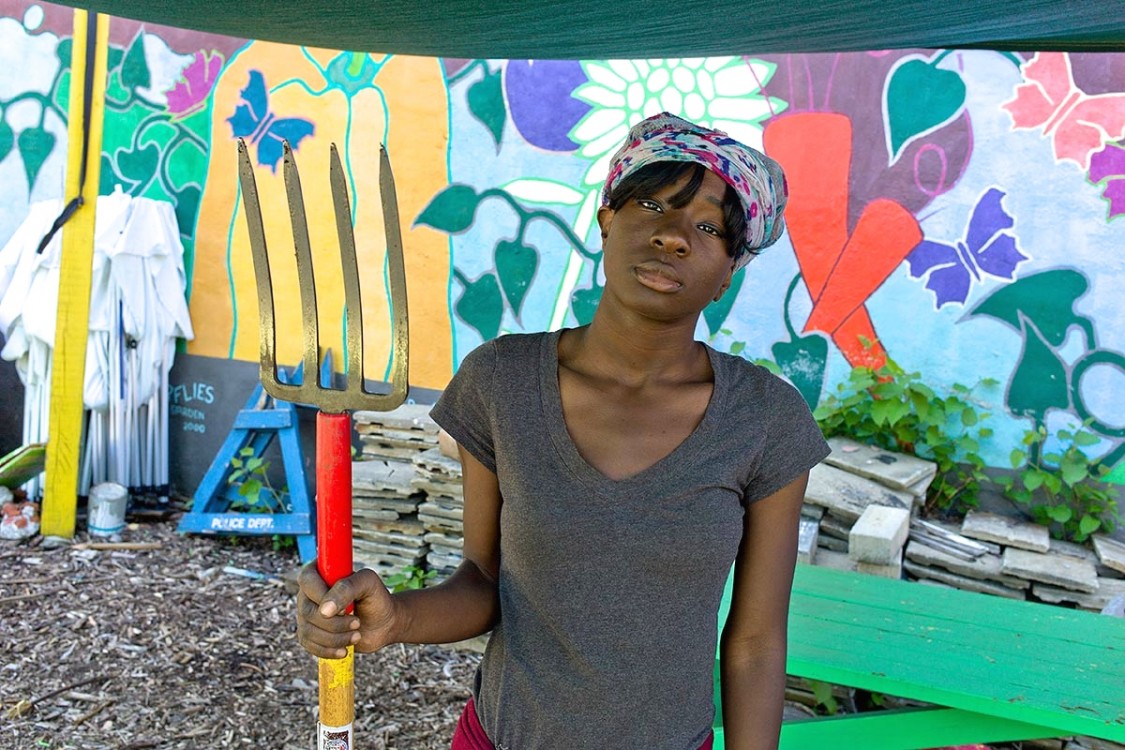
At a Saturday-morning farmers’ market in the underprivileged East New York section of Brooklyn, Joanna White is buying a bundle of freshly harvested beets, even though she’s pretty sure her teenage daughter will never agree to taste them. But White says that improving her family’s diet has meant trying new things, so she’s going to follow a recipe she picked up from a New York City health-department stand.
White, an information-technology trainer at New York University’s Langone Medical Center who just moved here from the nearby Bedford-Stuyvesant section, is delighted to have found the market. “Before, I had to leave my ZIP code to get my food,” she says.
As awareness of nutrition and healthy food rises, shoppers like White increasingly want local and organic food. But unlike in wealthier communities, where once- or twice-a-week farmers’ markets supplement the fresh produce available at well-stocked and easily accessible grocery stores, the farmers’ markets in less affluent neighborhoods like this one are often the only source of fresh food.
Recognizing this, most farmers’ markets in New York City (and, increasingly, those across the country) accept food stamps, while organizations that set up the markets are bringing them to underresourced areas, where vendors from regional farms sell directly to the people. (In New York City, since 2006, the number of farmers’ markets in high- and very-high-poverty ZIP codes has increased by 71 percent, and currently, 59 percent of the markets are in such areas. In fiscal year 2013, sales with food stamps at New York City farmers’ markets totaled $1,113,891.)
Organizers of the East New York Market — now in its eighth year — aren't holding their breath that a Whole Foods or Trader Joe’s will open nearby anytime soon, and the market is not dependent on farmers upstate to supply it. Much of the produce that is sold here is actually grown just blocks away.
The market was established by East New York Farms (ENYF), a project of the nonprofit United Community Centers. Started in 1998 to promote local sustainable agriculture and community-led economic development, ENYF had by 2000 turned an abandoned half-acre lot in the shadow of the subway tracks on Livonia and Schenck Avenues into an urban farm.
The farm is also adjacent to where the street market now opens each Saturday from June through November, and shoppers can see next week’s fare as it grows and ripens. Much of the paid work of planting, growing, harvesting and setting up the market is done by local youths. Forty-two independent local gardeners who farm in another 25 lots around East New York supply additional produce. Roughly 25 percent of the 3,000 pounds of produce sold at the market in the past year was grown in this part of Brooklyn, where many New Yorkers don’t dare to visit.
But don’t confuse what ENYF is doing with the foodie movement. Growing healthy food, selling it in the community and educating residents, especially young people, about farming and nutrition squarely establishes East New York Farms as a “food-justice” organization. The goal of the group and others like it is not only to expand access to good food, but also to improve residents’ health (poor communities tend to have higher rates of obesity, heart disease and diabetes); create jobs and new sources of income in the area; and transform blighted and underused parts of their neighborhoods into assets.
Jacquie Berger, executive director of Just Food, a nonprofit that works in underserved New York City communities to increase access to locally grown food, says that in the last 10 years, community-led efforts have been on the rise across the country. She says the recent economic downturn and the subsequent attention to job creation and economic equality, along with a growing awareness of food safety, diet-related diseases, food access and related issues, have combined to elevate food justice as a priority in many communities.
“Local, city, state and national officials are paying attention to food-policy issues; you even see it in pop culture with this meteoric rise of food TV,” she says. “Food impacts health, well-being, educational outcomes — so what a food system looks like can be empowering and help build a healthy community. Or it can be the opposite. It can undermine and take away its stability.”
But local food activists say that national conversations about food and urban agriculture, often associated with authors and chefs such as Alice Waters and Michael Pollan, speak primarily to the concerns of middle- and upper-class people and may overlook the social injustices ENYF and other groups seek to redress.
David Vigil, the project director of East New York Farms, worries that because of food’s recent pop-culture ascension, the group’s work will be seen as a fad — even though ENYF is 15 years old — and its critique of the larger systemic issues will be ignored.
“We don’t want to be seen as growing boutique food,” he says.
Siena Chrisman, an independent researcher and organizer focused on food-justice issues, says that what sets groups like ENYF apart from their middle-class counterparts is the urgency of their work.
“In East New York, you’ve got people where all of their family has diabetes. These are smart people, they know why, they know it’s food related,” she says. “And there’s not another option. Supermarkets aren’t coming, so this is coming from communities’ own needs.”
Early in the 20th century, East New York was one of the city’s major vegetable-producing areas and one of the last places in New York City to have commercial farms. The area eventually became more urban and home to a variety of immigrants. But as in other American cities, those earlier residents left or fled for the suburbs, which not only changed the demographics of the area but also created a glut of vacant and abandoned properties and lots. Poverty and crime followed.
In the early 1970s and ’80s, New York City’s community-gardening movement began, with residents trying to revitalize their neighborhoods by turning abandoned spaces into gardens. East New York developed more community gardens than any other part of the city, cared for by its own talented gardeners.
In the ’90s, organizers and community leaders in the neighborhood saw a resource in their midst, identifying the gardens as an opportunity to also generate income. They believed a move toward urban agriculture — namely, growing more produce than flowers — could simultaneously provide food, jobs, spaces to strengthen community bonds and educational opportunities for the neighborhood’s disenfranchised youth.
ENYF’s half-acre lot was bolstered by an influx of Caribbean-Americans, who brought farming skills and a market for produce from their homeland not widely available in grocery stores.
Today, ENYF grows a variety of produce (from greens and peppers, many of which are common in the Caribbean kitchen if less familiar to Americans, to more exotic fruits like figs); manages two urban farms; runs a community-supported agriculture program during the winter months; and connects a network of gardeners who sell what they grow at the farmers’ market. That can be a profitable enterprise. Prolific gardener Marlene Wilks, 62, estimates that she and her husband make $5,000 during the market season.
“It is not so much about the money, but being able to provide for people,” says Wilks, a former teacher and now a New York City Department of Education employee who saw firsthand the effects of poor nutrition on student performance. “The garbage they sell [in supermarkets] here you won’t find on the Upper West Side.”
The farmers’ market operates twice a week. Unsold food is either donated to nearby food kitchens or given to the market’s young employees.
In cities where housing stock exceeds demand, converting abandoned lots for agricultural use is easier than in New York City, according to Vigil. New York developers, he says, are always eyeing what might be the next neighborhood to gentrify, and snapping up vacant spaces to build new condominiums and retail stores.
A Brooklyn native, White, the woman who bought the beets, moved to East New York because she couldn’t afford to buy a house in the rapidly gentrifying Bedford-Stuyvesant, where she had lived since the 1990s.
On her first Saturday in her new neighborhood, before she’d even finished unpacking, White made the nearly mile-long walk from her three-story home to check out the market, which she had learned about through a Google search of fresh-food options.
She grew up in the projects in nearby Brownsville, where, she says, there were no fruit or vegetable stands and virtually no fresh food. In Flatbush, Brooklyn, where White and her family moved when she was 12, offerings were also slim. They would buy meat in bulk.
In 2007, a series of difficult-to-diagnose autoimmune diseases left her in constant pain, dependent on a walker and unable to work. The medications she was prescribed left her in turn lethargic, depressed and not herself. She decided to stop taking them.
An Indian-American friend suggested trying turmeric, a spice commonly used in South Asian cooking and known for its anti-inflammatory properties. White says she felt better after trying it and became curious about the curative properties of food. Eventually, she began changing her diet. Soon she was eating organic; eventually, she cut down on meat and dairy products. Weight came off, she no longer needed a walker, and she went back to work full-time.
She began shopping at Whole Foods and Trader Joe’s in Manhattan’s Union Square, going after work or on Saturdays, but she was limited by the high prices and what she could carry. “At Whole Foods, I can only buy what is on sale,” she says.
But in less privileged neighborhoods like East New York, White says, residents don’t demand fresh food because they often don’t know anything else.
“I’m an educated woman with a master’s degree,” she says. “Did I know veggies were vital? I didn’t.”
But White isn’t dwelling on the past. “It’s great at my age that I found this now: a new and better way of living. I’m excited about food again.”
Back home, after preparing the beets, along with their greens in a balsamic reduction, White corners her 14-year-old daughter, Jonaé Oldham, and offers her a tiny sliver.
Jonaé supports her mother’s outlook on health, and even took the lead in banning plastic bottles from their house and persuading her mom to adopt a “pescatarian” diet (which includes fish but not poultry, pork, beef or lamb), beginning in January of this year. But the only time she’s had beets was in a salad, she says, “and it was nasty.”
She wrinkles her nose as her mother approaches with a fork, but she tries it.
Her verdict? “It was good. And I love that it’s grown in East New York.”
But White isn’t dwelling on the past. “It’s great at my age that I found this now: a new and better way of living. I’m excited about food again.”
3 WAYS TO SHOW YOUR SUPPORT
- Log in to post comments
















